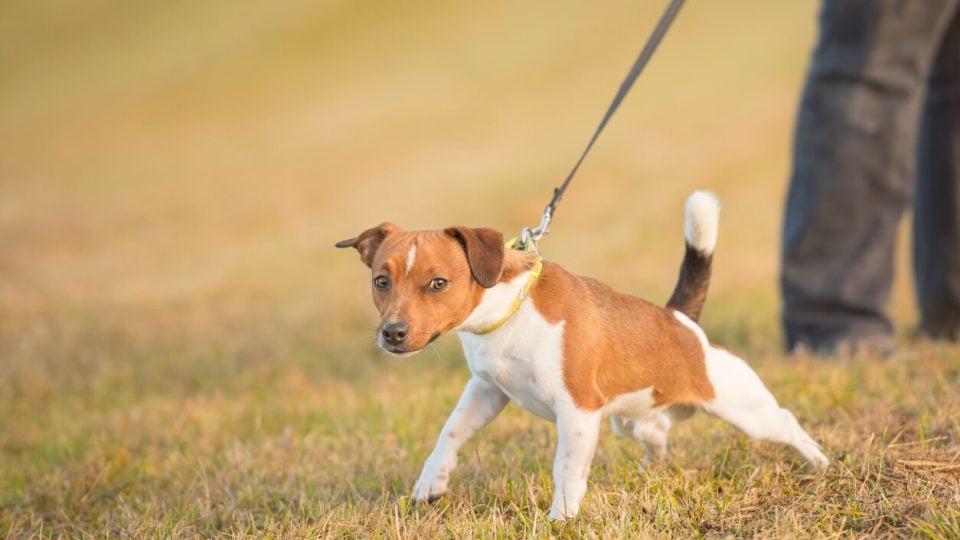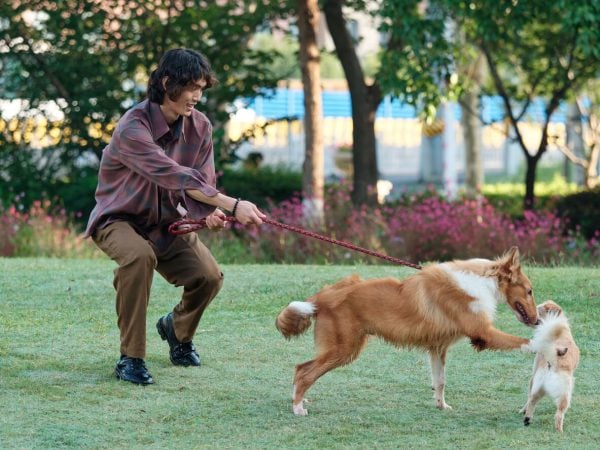- Not a substitute for professional veterinary help.
If you’ve ever noticed your dog’s hair standing on end, you’ve seen them raise their hackles! Hackles on a dog are the strip of fur that runs from the neck to the base of the tail.
Raised hackles are a clear sign of heightened arousal, but they don’t always mean aggression, explains Dr. Wayne M. Johnson, a veterinarian at Birdneck Animal Hospital. Since raised hackles are an involuntary reflex, known as piloerection, they can can happen both as part of the fight or flight response and during play.
While some hackles are less noticeable in breeds with curly or fluffy coats, all dogs have them. Some dogs, like Rhodesian Ridgebacks, appear to have permanently raised hackles, due to a “ridge” of backward-growing hair along the spine. Recognizing when your dog’s hackles are raised can help you figure out whether you need to defuse a situation or remove your dog.
Read on to learn how to learn why your dog’s hackles are raised and what experts say about supporting your dog through each situation.
Dog Hackles: Things to Know
When your dog’s hackles are up, there will be other behavioral signs for how your dog is truly feeling. Here is a cheat sheet for what emotions they are likely feeling so you know what to do next.
| Cause / Action | Tail | Ears | Mouth | Noise |
| Fear / Leave area | Tucked | Flattened | Drooling | Panting |
| Frustration / Soothe | Forward | Lip-licking | Barking | |
| Excitement / Calm | Wagging | Forward | Panting | Whining |
| Stress / Leave | Tucked | Siren-movement | Lip-licking | Panting |
| Curiosity / Approach slowly | Wagging | Perked | Closed |
Fear
Dogs usually raise their hackles due to fear, according to Shir Limazati, founder and head trainer at Another Chance Training.
When a dog encounters something they consider a threat, like another dog or a small child, they may raise their hackles to appear larger. You might notice this more often with younger dogs, who generally have more uncertainty about the world.
“This is a defensive strategy intended to ward off the perceived threat,” explains Qiai Chong, Chief Behaviourist at Pet Coach SG.
Dog hackles may also go up in response to loud, sudden noises like thunder or fireworks.
Along with raised hackles, you might notice:
- Stiff and lowered body posture
- Tucked tail
- Flattened ears
- Drooling
- Panting
- Sudden and excessive shedding
What to do next
If possible, calmly remove your dog from the situation causing their fear. For example, if your dog becomes afraid of another dog on a walk, gently redirect your dog’s attention and turn in another direction to create distance.
“Pay attention to the situations that cause your dog’s hackles to rise and try to manage or minimize these triggers when possible,” suggests Chong.
Avoid forcing your dog to confront the frightening stimulus, as this can amplify their fear and may lead to aggression or attempted escape. If the same things continually trigger your dog, Limazati recommends seeking help from a professional behaviorist or trainer who can help your dog manage their fear.
Proper socialization and positive reinforcement training can go a long way toward preventing fear responses in the future. “Gradually exposing your dog to different situations and teaching them to remain calm can help reduce unnecessary stress and prevent raised hackles,” explains Dr. Johnson.
Frustration
When a dog can’t reach something they want, like another dog, while they’re on a leash or indoors, Chong says they may display raised hackles as a sign of frustration and eagerness.
Along with raised hackles, you might observe:
What to do next
You can try redirecting your dog’s attention with a favorite toy or treat or calmly leading them away from the triggering stimulus.
It’s crucial to avoid punishing your dog in these situations, as this will only make their frustration worse. If your dog continues to have trouble on the leash, a professional trainer or behaviorist can provide more tailored advice on how to address leash reactivity.
Stress Or Uncertainty
Sometimes, dogs raise their hackles in response to sudden or unexpected stimuli. This reaction might happen when your dog encounters a new person or environment they’re not quite sure about yet.
Along with raised hackles, you might notice:
- Tucked tail
- Pacing
- Rigid body
- Tense or worried expression
- Drooling
- Lip-licking
- Vocalizing more than normal
What to do next
First, calmly remove your dog from the stressful environment. After that, you can try using cues like sit or down to help your dog relax, Chong suggests.
It’s also important to stay calm yourself to help reassure your dog and aid in the de-escalation, Chong says. A strong emotional reaction from you can add to your dog’s excitement or anxiety, which can make the situation worse.
Excitement Or Playfulness
When dogs feel playful or excited, their hackles may go up. This can happen when they’re thrilled to see a friend or explore a new space.
Along with raised hackles, you might notice:
- Pulling on the leash
- A playful demeanor
- Bouncy movements
- Relaxed mouth
- Wagging tail
- Bright eyes
What to do next
If your dog raises their hackles in excitement, you generally don’t need to worry. Just pay attention to their behavior to make sure they don’t get overstimulated.
Even positive arousal, like excitement, can sometimes turn into negative emotions like frustration or aggression, according to Chong.
A dog who’s becoming overstimulated may begin pacing, hold their tail high and stiff, or have an intense focus while pulling on the leash. If you notice these signs, it’s best to help your dog calm down. You can refocus their energy with a toy, treat, or a puzzle.
Curiosity
Raised hackles can also be a sign of a dog’s inquisitiveness, Chong says. You might notice this response when your dog meets new people and other dogs or goes to an unfamiliar place with intriguing scents.
Along with raised hackles, you might notice:
- Forward-leaning posture
- Perked ears
- Focused expression
What to do next
Curiosity is mostly good, so all you need to do is monitor your dog’s reaction and behavior to make sure their emotions stay balanced!
You probably don’t need to worry if your dog shows some casual interest in passing joggers. But of course, you don’t want them lunging and barking at the end of the leash.
Pay attention as you let your dog explore at their own pace, and be ready to relocate if you notice any signs of fear, aggression, or overstimulation. These signs might include a rigid stance or a tense rather than relaxed appearance.
How To Read Your Dog’s Body Language
Understanding your dog’s body language, including raised hackles, is a key part of interpreting their emotions and reactions in various situations. By observing your dog’s posture, facial expressions, tail movements, and ear positions, you can learn a lot about how they’re feeling.
To get better at reading your dog’s body language, all you have to do is spend quality time with them and pay attention. In time, you’ll pick up patterns and behaviors that help you understand your dog and meet their unique needs.
This understanding both helps you keep your dog safe and also fosters a strong and trusting bond between the two of you. Understanding your dog’s emotions makes it easier to support them in a way where they feel safe and comfortable!




